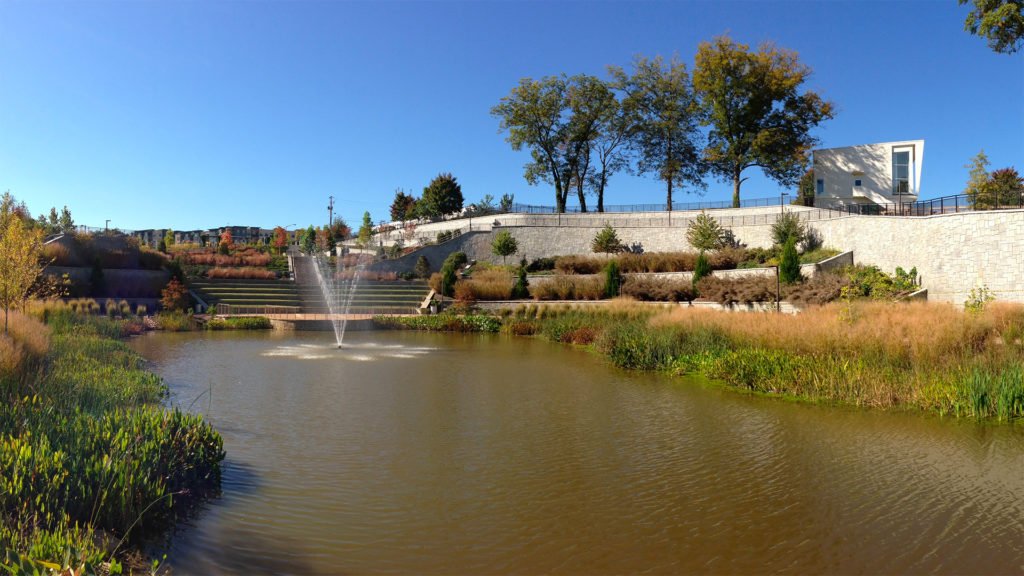What is stormwater?
Stormwater is rainwater or melted snow that flows over the land. A watershed is the land that drains into a stream, river, lake, or other body of water. Watersheds can be large, like the Flint River watershed, or small, like the Cedar Creek watershed. No matter where you are (even where you are reading this right now), you are in a watershed. Actions that we take on the land impact our water resources because land (both natural and constructed surfaces) makes up the watershed where stormwater flows.
Stormwater is important to our quality of life because of the benefits it provides to the environment and our communities. It replenishes our water supply and contributes to maintaining groundwater and surface water flows that support aquatic life and habitat. In the Metro Water District where almost all of our drinking water comes from surface water, stormwater is very important to replenish our water supply. When properly managed, it also provides clean water for recreation, which brings economic benefit and fun to a community.
Find Your WatershedHow is stormwater managed in our region?
Stormwater management helps reduce erosion, improve water quality, and protect public health and safety. The Metro Water District evaluates a wide spectrum of management strategies to develop a comprehensive regional program that protects our water quality and promotes watershed health. By implementing these programs, stormwater quality and quantity can be managed to reduce flooding and water quality impacts.
Sustainable stormwater management balances the needs of all stakeholders and the natural environment. Rivers and watersheds do not stop at the Metro Water District’s jurisdictional boundaries. Water connects us to the rest of Georgia, and our watershed protection efforts will benefit others downstream. It is the responsibility of everyone to protect stormwater and our water resources for the future.
Communities with source water supply watersheds within their jurisdictions must implement specific activities to protect public drinking water supplies. These include protecting the land near water sources from activities that could have a negative impact on water quality, coordinating by local jurisdictions and water providers on issues related to source water supply protection, and implementing inter-jurisdictional agreements. Additionally, communities with water bodies that do not meet water quality standards must develop an implementation plan that outlines stakeholder actions to address the water quality impairment and different types of pollution.
The Georgia Stormwater Management Manual provides a host of solutions for stormwater management, including permeable paver systems, pervious concrete, porous asphalt, soil restoration, and site reforestation/revegetation that manage stormwater runoff and improve water quality.

What affects stormwater quantity?
As impervious (hard/non-porous) surfaces such as rooftops and roads increase, there are fewer opportunities for rainfall to naturally soak into the environment. Early stormwater management systems like pipes and ditches were designed to manage stormwater quantity (or volume) and move it back into local waterways. This was primarily to protect homes and businesses from flooding and to get water quickly off the roadways to prevent hydroplaning and keep drivers safe. Stormwater in these older systems was not treated at a facility like wastewater, and over time began to harm surface water sources that serve as our drinking water supplies.
In recent years, stormwater management systems have evolved to include elements to improve water quality as well as manage water quantity. There are still challenges with flooding and stormwater management, but the Metro Water District and local jurisdictions are continuing to implement policies and programs to support water quality improvement and flood reduction goals.
The EPA’s National Stormwater Calculator is a desktop application that estimates the annual amount of rainwater and frequency of runoff from a specific site anywhere in the United States (including Puerto Rico). Estimates are based on local soil conditions, land cover, and historic rainfall records.

What affects stormwater quality?
Land development affects the physical, chemical, and biological conditions of the Metro Water District’s watersheds, waterways, and water resources. As land cover changes from forested and rural to suburban and urban (developed) use, the natural cycle of water (hydrology) is altered. For example, tree clearing removes the vegetation that intercepts, slows, and returns rainfall to the air through evaporation and transpiration. The addition of buildings, roadways, parking lots, and other surfaces that are impervious to rainfall further reduces stormwater’s ability to soak into the ground and increases runoff.
Nonpoint source pollution is a form of water pollution that does not originate from a discrete point such as a wastewater treatment plant or industrial discharge but involves the transport of pollutants such as sediment, fertilizers, pesticides, oil, bacteria, and other contaminants from land to surface water through precipitation, and stormwater runoff. Point source pollution is a form of water pollution that occurs when a contaminant comes from a single obvious source, like wastewater treatment plant or industrial discharge. Watersheds and waterways can become polluted by both point source and nonpoint sources of pollution.

